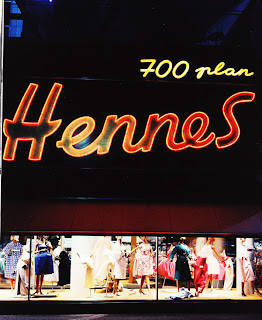H&M Neon Sign Mystery In Sweden
"700 plan" is simple enough, but the old neon sign makes no sense at all. What does it mean? The Swedish newspaper SVD decided to outsource the question, and after a couple of days, an answer was found. Something about 700 square meters, or whatever, as a promotion for a new shop.
I like how Sweden had a totally un-metric unit, the "plan" back in the 1950s. These days, we are all too standardized to care.
Japan, of course, has tatami mats as the way to go (make that "sleep"). Soft to step on, made from rice, with a certain bounce.
One tatami mat is just about 2 square meters, by the way, but since the days of the Silver Pavilion was built in Kyoto, or whenever, the 2.73 m × 3.64 m (6 mat) room is a standard.
 Isn't wikipedia amazing, here is the page for tatami.
Isn't wikipedia amazing, here is the page for tatami.
Korea also has the pyeong (tsubo) and in Taiwan, the ping is used.
I digress, but for a reason.
The United States is sometimes blamed as the only country on Earth that does not do "metric" for whatever logic, I do not know.
Here, more about the yard.
There are a lot of curious units found in East Asia.
Japan, on the other hand, is perfectly able to juggle both the metric standard and the old measurements.Since the Meiji era, it decided to go with the flow, and that turned out to be the European flow.
I like how the simple mat that I sleep on has such historical connotations.
Update: Parts of a Japanese house has been found as far away as Seattle, having floated all the way since the tsunami last year: Washington kayakers find parts of tsunami-hit house
I like how Sweden had a totally un-metric unit, the "plan" back in the 1950s. These days, we are all too standardized to care.
Japan, of course, has tatami mats as the way to go (make that "sleep"). Soft to step on, made from rice, with a certain bounce.
One tatami mat is just about 2 square meters, by the way, but since the days of the Silver Pavilion was built in Kyoto, or whenever, the 2.73 m × 3.64 m (6 mat) room is a standard.
 Isn't wikipedia amazing, here is the page for tatami.
Isn't wikipedia amazing, here is the page for tatami.Korea also has the pyeong (tsubo) and in Taiwan, the ping is used.
I digress, but for a reason.
The United States is sometimes blamed as the only country on Earth that does not do "metric" for whatever logic, I do not know.
Here, more about the yard.
Metrication is the process of introducing the International System of Units (SI or Système International), a metric system of measurement, to replace the historical or customary units of measurement of a country or region. While all U.S customary units have been redefined in terms of SI units, the United States does not officially use or mandate a metric system of units, making it one of only three countries, along with Burma (Myanmar) and Liberia, that have not adopted the SI as their official system.
There are a lot of curious units found in East Asia.
Japan, on the other hand, is perfectly able to juggle both the metric standard and the old measurements.Since the Meiji era, it decided to go with the flow, and that turned out to be the European flow.
I like how the simple mat that I sleep on has such historical connotations.
Yoshimasa's retirement villa became known as the temple Ginkaku-ji (the Temple of the Silver Pavilion) after his death. It is situated in Kyoto's Sakyō-ku,
and was the center of the Higashiyama cultural outgrowth in a number of
ways. The Pavilion is revered for its simple beauty, the silver having
never been added. The rock garden next to it is likewise one of the most
famous in Japan, and praised for its Zen and wabi-sabi
aesthetics. It is a quintessential example of the idea that only the
trained expert should be able to recognize the subtle beauty within art
and architecture; the beauty of the object should not be underscored and
emphasized, but gently hidden. The retired shogun also invited many
artists, poets, and court nobles to his villa, encouraging the
development of their arts.
The Tōgudō building includes a shoin-style room called the
Dōjinsai. It originally had a fireplace built into the floor, and due to
this, the Dōjinsai is considered the earliest extant example of a room
designed for use as a tea room.[1]
Update: Parts of a Japanese house has been found as far away as Seattle, having floated all the way since the tsunami last year: Washington kayakers find parts of tsunami-hit house





Comments